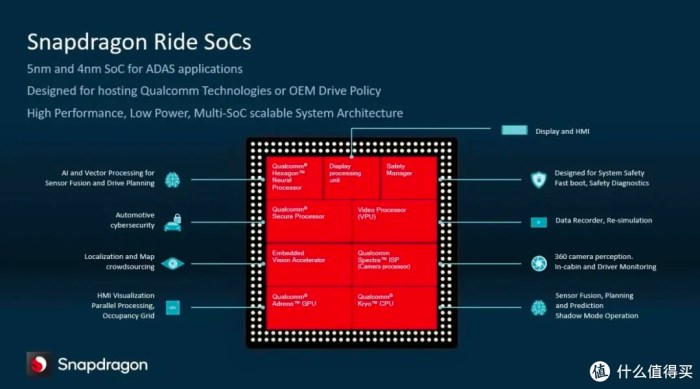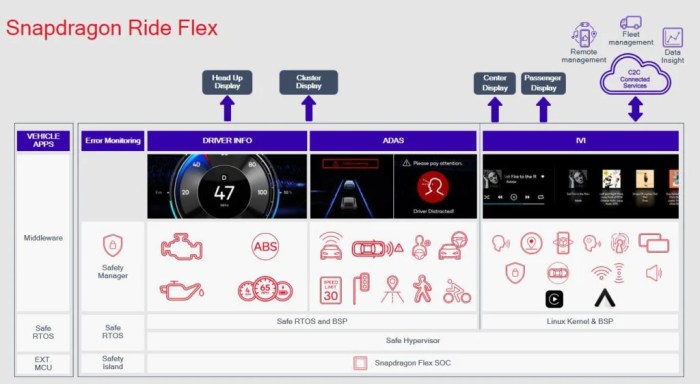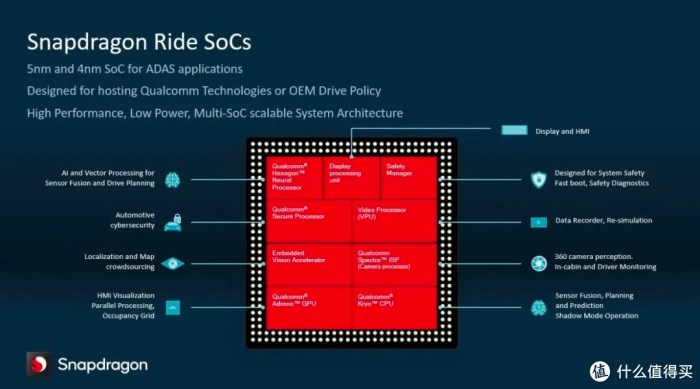
Qualcomm Snapdragon Ride Flex SoC: The Future of Automotive Technology
Qualcomm Snapdragon Ride Flex SoC is revolutionizing the automotive industry, offering a powerful and versatile platform for advanced driver-assistance systems (ADAS) and autonomous driving. This cutting-edge system-on-a-chip (SoC) is designed to handle the complex demands of modern vehicles, providing the computational power and flexibility needed to enable a wide range of innovative features.
The Snapdragon Ride Flex SoC boasts a sophisticated architecture, including high-performance processor cores, advanced graphics capabilities, and dedicated AI processing units. This combination empowers vehicles to perceive their surroundings with exceptional accuracy, make intelligent decisions in real-time, and execute complex driving maneuvers with enhanced safety and efficiency.
Introduction to Qualcomm Snapdragon Ride Flex SoC
The Qualcomm Snapdragon Ride Flex SoC is a powerful and versatile system-on-a-chip (SoC) designed to accelerate the development and deployment of autonomous driving systems. It is a comprehensive solution that combines high-performance computing, advanced safety features, and flexible architecture to address the diverse needs of the automotive industry.This SoC is a crucial component in the evolution of autonomous driving, offering a robust platform for developers to create innovative and reliable self-driving systems.
Target Applications and Market Segments
The Snapdragon Ride Flex SoC is designed for a wide range of automotive applications, including:* Advanced Driver-Assistance Systems (ADAS):These systems provide drivers with real-time assistance, enhancing safety and comfort. Examples include adaptive cruise control, lane keeping assist, and automatic emergency braking.
Automated Driving Systems (ADS)
These systems enable vehicles to drive autonomously, from Level 2 to Level 5 autonomy, offering a future where cars can drive themselves.
Robotaxis and Autonomous Shuttles
The SoC is well-suited for self-driving vehicles designed for ride-hailing services and public transportation.
Commercial Vehicles
The Snapdragon Ride Flex SoC can be used in trucks, buses, and other commercial vehicles to enhance safety and efficiency.The SoC targets various market segments, including:* Tier 1 Automotive Suppliers:These companies design and manufacture automotive components, including ADAS and ADS systems.
Automotive OEMs (Original Equipment Manufacturers)
Car manufacturers who integrate ADAS and ADS features into their vehicles.
Emerging Mobility Companies
Startups and companies focused on developing autonomous driving solutions.
Key Features and Innovations
The Snapdragon Ride Flex SoC offers a comprehensive set of features and innovations that cater to the demanding requirements of autonomous driving:* High-Performance Computing:The SoC integrates multiple high-performance processors, including CPUs, GPUs, and AI accelerators, to handle the complex computational tasks involved in real-time perception, decision-making, and control.
Advanced Safety Features
The SoC incorporates dedicated safety mechanisms, such as hardware-based safety islands and fault tolerance, to ensure system reliability and mitigate potential risks.
Flexible Architecture
The Qualcomm Snapdragon Ride Flex SoC is designed for autonomous vehicles, and its ability to process vast amounts of data makes it a powerful tool for a wide range of applications. One such application is in the realm of financial management, where keeping track of expenses is crucial.
If you’re looking for ways to stay on top of your budget, check out some of the best expense tracker apps available. Just like the Snapdragon Ride Flex SoC is revolutionizing automotive technology, these apps can help you gain control over your finances.
The Snapdragon Ride Flex SoC offers a flexible architecture that allows developers to customize the system to meet specific application requirements. This includes support for various sensor configurations, software frameworks, and computing power levels.
Scalability
The SoC is scalable, enabling developers to adapt the system to different levels of autonomy and performance requirements. This allows for a gradual transition to higher levels of autonomy as technology advances.
Software Ecosystem
Qualcomm provides a comprehensive software ecosystem for the Snapdragon Ride Flex SoC, including tools, libraries, and frameworks that simplify development and deployment of autonomous driving systems.
Key Advancements Compared to Previous Generations
The Snapdragon Ride Flex SoC represents a significant advancement over previous generations of automotive SoCs, with key improvements in:* Performance:The SoC delivers a significant increase in computing power, enabling the processing of vast amounts of data from sensors and algorithms.
The Qualcomm Snapdragon Ride Flex SoC is a powerful chip designed for automotive applications, and it’s impressive how it can handle complex tasks like advanced driver-assistance systems (ADAS) and infotainment. It’s exciting to see how this technology is driving innovation in the automotive industry, and it even extends to the home with devices like Samsung’s new 32-inch smart monitor.
This monitor, a refresh with 4K resolution, USB-C connectivity, and AirPlay , is the perfect companion for Mac users, offering a seamless and high-quality experience. And with the Snapdragon Ride Flex SoC powering these innovations, the future of technology looks incredibly bright.
Safety
The Qualcomm Snapdragon Ride Flex SoC is a powerful platform for automotive applications, offering a wide range of capabilities for ADAS and autonomous driving. With its advanced processing power, it can handle complex tasks like object detection and path planning.
If you’re looking for a reliable and affordable way to manage your documents and spreadsheets, you might want to check out the OfficeSuite Personal Plan lifetime subscription. It’s a great option for both personal and professional use. Back to the Snapdragon Ride Flex SoC, its modular architecture makes it adaptable to different vehicle configurations, ensuring that it can meet the specific needs of each project.
The SoC incorporates enhanced safety features, including hardware-based safety islands and advanced fault tolerance mechanisms, to ensure system reliability and safety.
Flexibility
The SoC offers greater flexibility in terms of configuration and customization, allowing developers to tailor the system to specific application needs.
Scalability
The Snapdragon Ride Flex SoC is scalable to meet the evolving needs of autonomous driving, allowing for a gradual transition to higher levels of autonomy.
“The Snapdragon Ride Flex SoC is a key enabler for the future of mobility, providing a powerful and flexible platform for developers to create innovative and reliable autonomous driving systems.”
Qualcomm
Architecture and Design

The Qualcomm Snapdragon Ride Flex SoC is a powerful and versatile platform designed for a wide range of automotive applications. It is built on a modular architecture that allows for customization and scalability, enabling it to meet the diverse requirements of autonomous driving, advanced driver-assistance systems (ADAS), and infotainment systems.This section delves into the architectural details of the Snapdragon Ride Flex SoC, exploring its core components, subsystems, and software support.
Processor Cores
The Snapdragon Ride Flex SoC features a heterogeneous compute architecture, combining different types of processor cores to optimize performance and efficiency. These cores include:
- High-performance CPU cores: These cores are responsible for running demanding tasks such as autonomous driving algorithms, image processing, and complex calculations. They provide high computational power and are typically based on the ARM Cortex-A series.
- Energy-efficient CPU cores: These cores are designed for low-power operation and handle less demanding tasks like system management and background processes. They contribute to extending battery life and reducing overall power consumption.
- GPU cores: The GPU cores are responsible for rendering graphics, accelerating computer vision tasks, and handling multimedia processing. They are crucial for providing a smooth and responsive user experience in infotainment systems and for supporting advanced ADAS features.
- DSP cores: DSP cores are specialized processors that excel in handling signal processing tasks such as audio processing, sensor data fusion, and machine learning inference. They are essential for ADAS functionalities like object detection, lane keeping, and adaptive cruise control.
Memory Configurations, Qualcomm snapdragon ride flex soc
The Snapdragon Ride Flex SoC supports various memory configurations to accommodate different system requirements. These include:
- High-bandwidth LPDDR5 memory: This type of memory provides high data transfer rates, enabling the SoC to handle demanding workloads efficiently.
- High-capacity storage: The SoC supports a variety of storage options, including flash memory and eMMC, providing ample space for storing data, software, and multimedia content.
Connectivity Options
The Snapdragon Ride Flex SoC offers a comprehensive suite of connectivity options to ensure seamless communication within the vehicle and with the external environment. These include:
- Ethernet: High-speed Ethernet interfaces allow for fast data transfer between the SoC and other vehicle systems, including cameras, sensors, and network devices.
- USB: USB ports provide connectivity for peripherals, such as infotainment displays, cameras, and external storage devices.
- Wi-Fi and Bluetooth: Wireless connectivity enables communication with smartphones, tablets, and other devices, facilitating infotainment features and remote access.
- Cellular connectivity: Cellular modems provide high-speed internet access and support for connected car features, enabling services like vehicle telematics, over-the-air updates, and emergency response systems.
Software and Operating System Support
The Snapdragon Ride Flex SoC is designed to be highly flexible and adaptable, supporting a variety of operating systems and software environments.
- Android Automotive OS: This operating system is specifically designed for automotive applications and provides a rich and customizable platform for infotainment systems, instrument clusters, and connected car features.
- Linux: Linux is a widely used operating system in automotive applications, providing a stable and reliable platform for ADAS and autonomous driving systems.
- QNX: QNX is a real-time operating system (RTOS) known for its reliability and safety features, making it suitable for critical automotive applications.
Automotive Applications
The Snapdragon Ride Flex SoC is designed to power a wide range of automotive applications, from advanced driver-assistance systems (ADAS) to fully autonomous driving. Its flexible architecture and powerful processing capabilities enable automakers to develop innovative features that enhance safety, efficiency, and comfort for drivers and passengers.
Applications of Snapdragon Ride Flex SoC
The Snapdragon Ride Flex SoC finds its place in various automotive applications, including:
- ADAS (Advanced Driver-Assistance Systems): The SoC powers features like adaptive cruise control, lane keeping assist, blind spot monitoring, and automatic emergency braking. These features use sensors and cameras to monitor the vehicle’s surroundings and provide alerts or take corrective actions to prevent accidents.
- Autonomous Driving: The SoC’s powerful processing capabilities enable Level 2 to Level 5 autonomous driving functionalities. It can process data from multiple sensors, including cameras, lidar, radar, and ultrasonic sensors, to create a comprehensive understanding of the vehicle’s surroundings. This information is then used to make decisions about steering, acceleration, and braking, allowing the vehicle to navigate autonomously.
- Infotainment Systems: The SoC powers advanced infotainment systems with features like high-resolution displays, voice control, and connectivity options. It can also handle complex graphics and multimedia processing, providing an immersive entertainment experience for passengers.
- Digital Instrument Clusters: The SoC enables digital instrument clusters with customizable displays and advanced graphics. It can display information like speed, fuel level, navigation instructions, and driver assistance alerts in a clear and concise manner.
- Connectivity: The SoC supports various communication protocols, including 5G, Wi-Fi, Bluetooth, and Ethernet. This enables vehicles to connect to the internet, communicate with other vehicles, and access cloud-based services.
Enabling Advanced Driver-Assistance Systems (ADAS)
The Snapdragon Ride Flex SoC plays a crucial role in enabling ADAS features. For instance, its powerful processing capabilities allow it to process data from multiple cameras and sensors in real-time, enabling features like:
- Lane Keeping Assist (LKA): The SoC processes data from cameras and sensors to detect lane markings and ensure the vehicle stays within its lane. If the vehicle starts to drift out of its lane, the SoC can provide steering assistance to keep it centered.
- Adaptive Cruise Control (ACC): The SoC uses radar and camera data to maintain a safe distance from the vehicle ahead. It automatically adjusts the vehicle’s speed to maintain a predetermined following distance, reducing driver fatigue and enhancing safety.
- Automatic Emergency Braking (AEB): The SoC can detect potential collisions with other vehicles, pedestrians, or objects. If a collision is imminent, it can automatically apply the brakes to mitigate or prevent the impact.
Enhancing Safety, Efficiency, and Comfort
The Snapdragon Ride Flex SoC contributes significantly to enhancing safety, efficiency, and comfort in vehicles.
- Safety: By enabling ADAS features like AEB, LKA, and ACC, the SoC helps prevent accidents and improve overall road safety. Its powerful processing capabilities allow for real-time decision-making and quick responses to potential hazards.
- Efficiency: The SoC can optimize fuel consumption by enabling features like adaptive cruise control, which reduces unnecessary acceleration and braking. It can also enhance traffic flow by enabling connected vehicle technologies that allow vehicles to communicate with each other and infrastructure.
- Comfort: The SoC powers advanced infotainment systems, digital instrument clusters, and connectivity features that enhance the driving experience. It provides passengers with access to entertainment, information, and convenience features, making long journeys more enjoyable.
Performance and Efficiency

The Snapdragon Ride Flex SoC is designed to deliver high performance and efficiency for a variety of automotive applications. This is achieved through a combination of powerful processing capabilities, advanced graphics rendering, and optimized power consumption.
Processing Power
The Snapdragon Ride Flex SoC boasts a powerful CPU and GPU that can handle demanding tasks like advanced driver-assistance systems (ADAS), autonomous driving, and infotainment systems.
- The CPU is capable of processing large amounts of data in real-time, enabling features like lane keeping assist, adaptive cruise control, and automatic emergency braking.
- The GPU handles the complex graphics rendering required for immersive user interfaces, 3D mapping, and advanced visualization for ADAS features.
AI Inference
The SoC integrates a dedicated AI engine that accelerates machine learning tasks, enabling features like object recognition, pedestrian detection, and gesture control.
- This AI engine can process data from multiple sensors, including cameras, radar, and lidar, to provide a comprehensive understanding of the surrounding environment.
- The AI engine is also optimized for low-power consumption, allowing for extended operation without significantly impacting battery life.
Power Consumption and Thermal Management
The Snapdragon Ride Flex SoC is designed to operate efficiently and minimize power consumption, reducing the strain on the vehicle’s battery and extending its range.
- The SoC incorporates advanced power management techniques, such as dynamic voltage and frequency scaling, to adjust power consumption based on the workload.
- The SoC’s thermal management system ensures efficient heat dissipation, preventing overheating and maintaining optimal performance.
Performance Comparison
Compared to other automotive-grade SoCs, the Snapdragon Ride Flex SoC offers a significant performance advantage in terms of processing power, graphics rendering, and AI inference capabilities.
- This performance advantage translates to faster processing times, smoother graphics, and more responsive AI features, enhancing the overall user experience.
- Furthermore, the SoC’s optimized power consumption and thermal management contribute to longer battery life and improved reliability, making it a compelling choice for demanding automotive applications.
Future Trends and Developments: Qualcomm Snapdragon Ride Flex Soc
The automotive industry is undergoing a rapid transformation, driven by technological advancements, evolving consumer preferences, and stringent regulatory requirements. The Snapdragon Ride Flex SoC is positioned to play a pivotal role in this evolution, enabling a wide range of innovative features and capabilities.
Emerging Applications and Use Cases
The Snapdragon Ride Flex SoC’s versatility and scalability make it suitable for a diverse range of automotive applications beyond traditional infotainment and ADAS systems.
- Advanced Driver Assistance Systems (ADAS): The SoC’s powerful processing capabilities and support for multiple sensor types will drive the development of more sophisticated ADAS features, such as adaptive cruise control with lane keeping assist, automated emergency braking, and advanced driver monitoring systems. These systems will enhance safety, reduce accidents, and improve driver comfort.
- Autonomous Driving: As the automotive industry moves towards autonomous vehicles, the Snapdragon Ride Flex SoC will be instrumental in enabling the complex computing requirements for self-driving systems. Its high-performance computing capabilities will support real-time perception, path planning, and decision-making, facilitating the development of Level 4 and 5 autonomous vehicles.
- Connected Car Technologies: The SoC’s integrated connectivity features, including 5G support, will enable seamless integration of connected car services. This will enhance the user experience with features like over-the-air updates, remote diagnostics, and real-time traffic information, transforming the vehicle into a mobile hub.
- In-Vehicle Infotainment: The Snapdragon Ride Flex SoC’s multimedia processing capabilities will revolutionize in-vehicle infotainment systems. It will enable immersive entertainment experiences with high-resolution displays, advanced audio systems, and interactive interfaces. Additionally, it will support the integration of personalized and cloud-based services, enhancing the driver and passenger experience.







